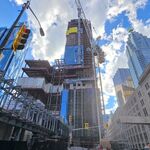Phase 2 is not relevant. The coverage for the initial $8-billion is much poorer than Transit City. At least I fix my grammar mistakes when they are pointed out ... and your comparing a post I wrote in 5 seconds to a comprehensive document that I would have thought someone would have proofed?
I fail to see how Phase 2 is not relevant. The money for it has not dissapeared, merely delayed. You're just choosing to ignore it because it makes Transit City look even worse when they're stacked up side by side. Phase 2 also brings the total of the plan to just under $15 billion.
And had someone had pointed out the grammar mistakes, I would have fixed them as well. But I fail to see how accidentally putting "it's" instead of "its" undermines my qualifications as a transit planner. It does not make my arguments any less correct, or any less valid. Had it have been a number typo, putting in $10,000 instead of $100,000, then there would be more of a reason for objection.
The primary problem with the existing SRT is a lack of frequency to provide the capacity. Why are you deceiving people by saying the capacity is about the same. The current trains are 51-metres long, and the new LRT trains will be 96 metres long. Given the width is similiar, anyone can see the capacity of each train is almost double. Even with a small increase in frequency from the current service, it will easily be able to handle double the current demand. And there's still a lot of opportunity to increase the frequency.
Doubling the carrying capacity won't really do much good if you don't widen the platform at STC. From what I have read, I also believe they are not extending the platforms at any of the existing stations, so having doubled trains won't really do much good if you can't fit them in the station. Even the TTC projects ridership to hit 10,000 pphpd by 2031, I'd say that's pretty solid subway ridership numbers, so please don't tell me the demand isn't there, or that it won't be there.
It is a great improvement - especially with the new underground LRT platform at Kennedy. As you don't seem to understand that the capacity is significantly incraesed, I don't see how you can opine on the need for a subway.
Because extending an LRT line into Malvern (which it doesn't even do in Phase 1, did you add that to your "communities left out of TC" list?) is overkill, and an LRT from STC to Kennedy is underkill. Unfortunately, the two don't really balance out. What's so wrong with having a transferless ride from STC to Bloor-Yonge? The SRT revamp and extension is in the same ballpark in terms of dollars as a subway extension to STC.
What kind of case is that ... the numbers must be wrong, but if I pull something out of my imagination, it would be necessary?
No, I'm just saying that the TTC did their projections for an LRT line. Subways generate more riders than LRT lines do.
And I also find it funny that you completely ignored my 'unserved neighbourhoods' rebuttal. With TC, Scarborough gets virtually no new service, aside from an LRT along Sheppard which shouldn't even be there. Downtown gets nothing. East York gets nothing. West Etobicoke gets nothing. The airport gets nothing. Yes, TC has much better coverage than MoTo, especially to key areas. Who needs a DRL right away anyway? It can wait until after the single family homes and strip malls along Sheppard get their LRT.




